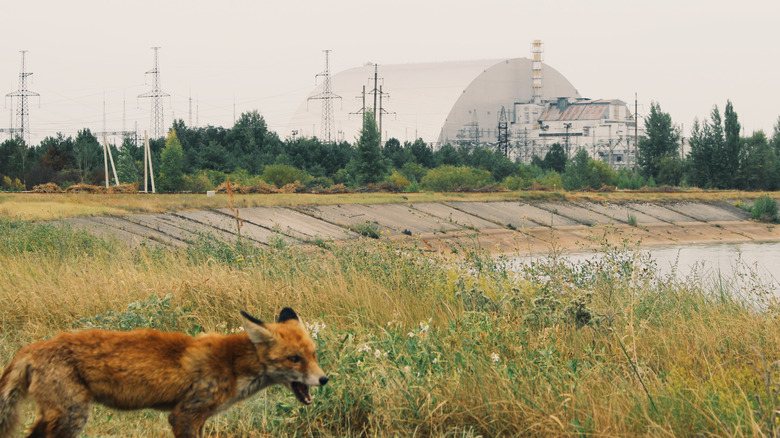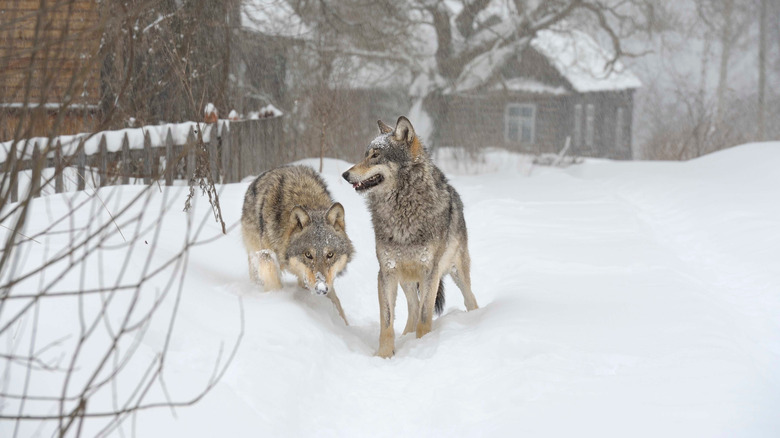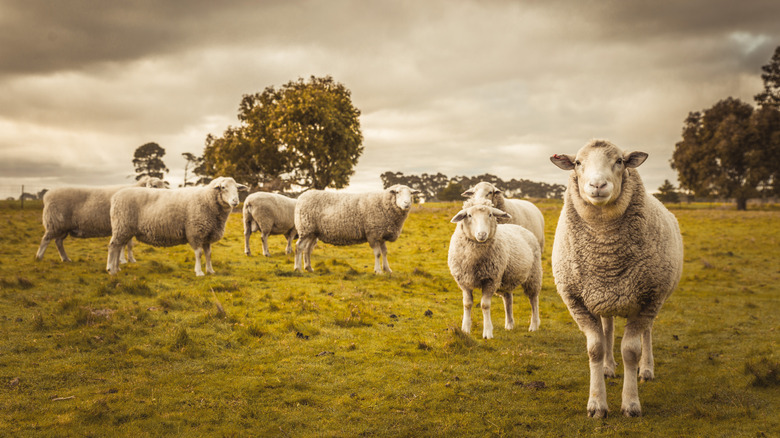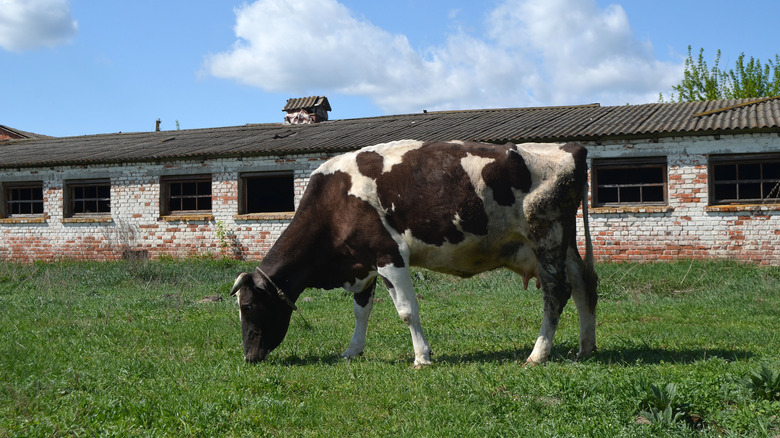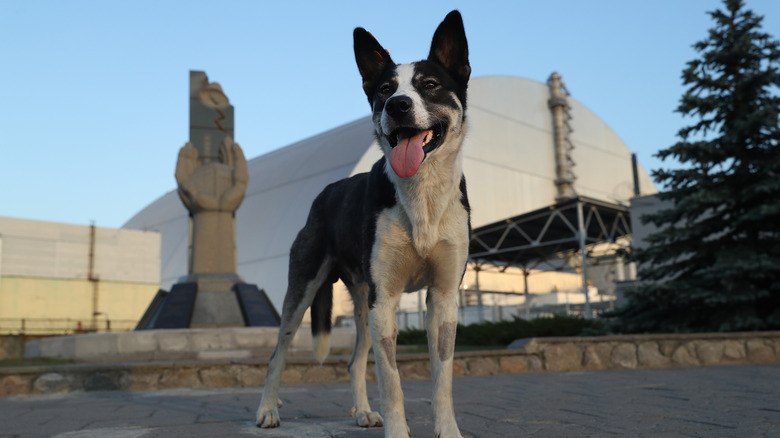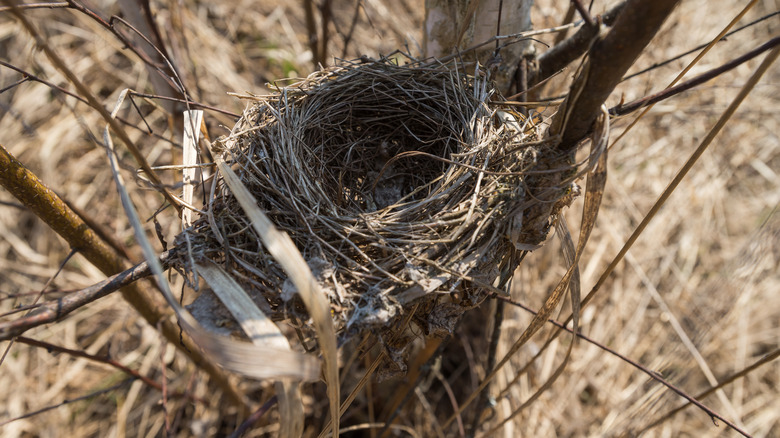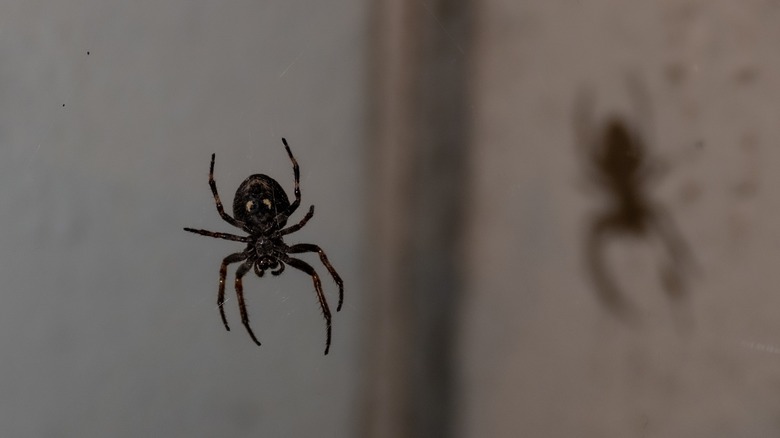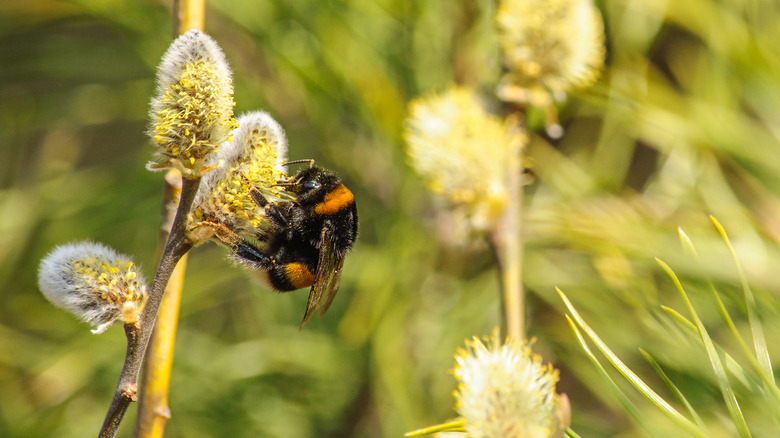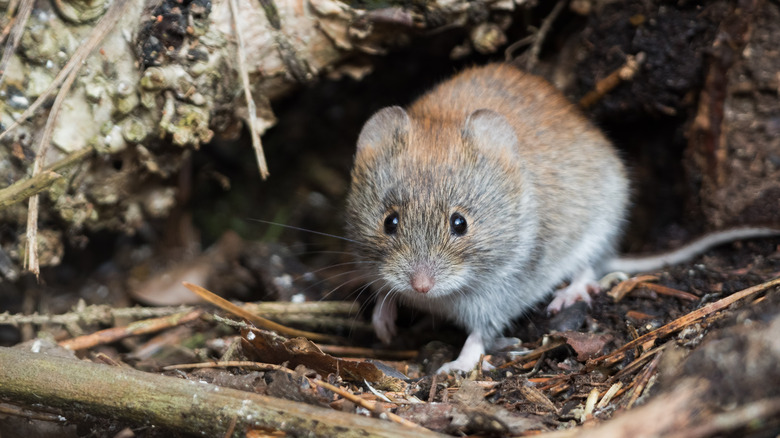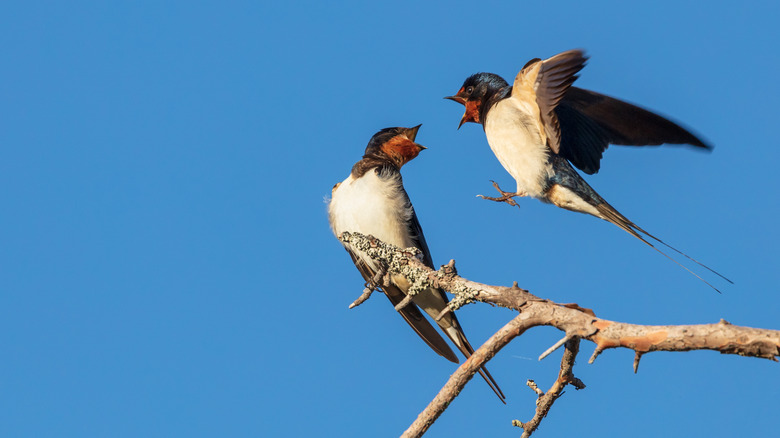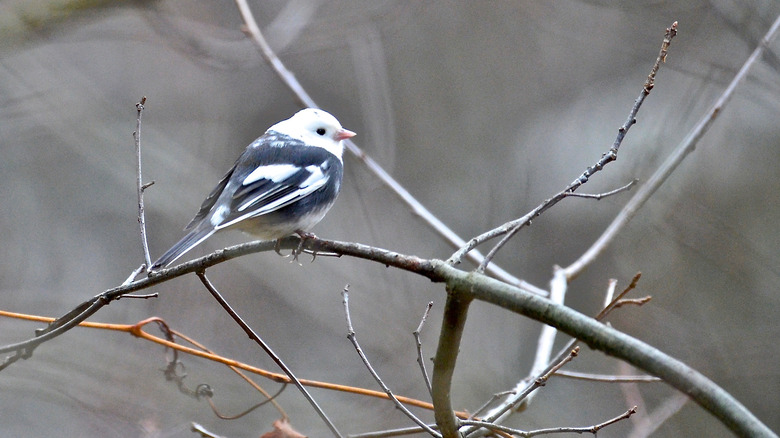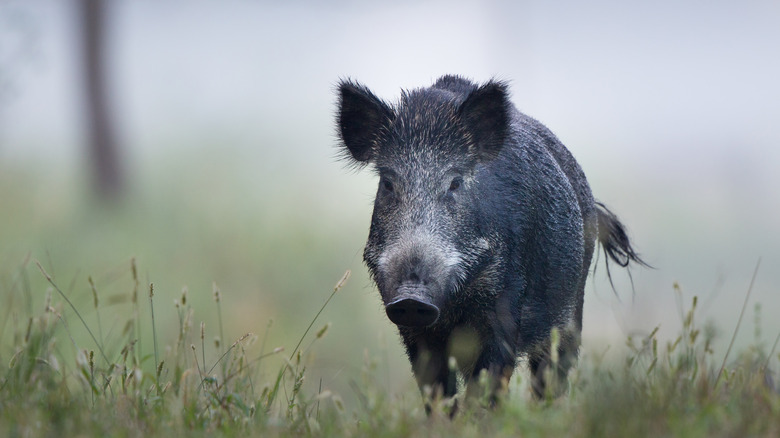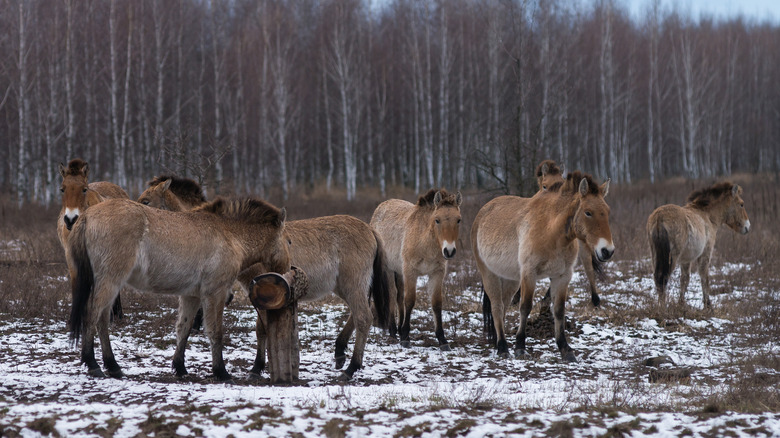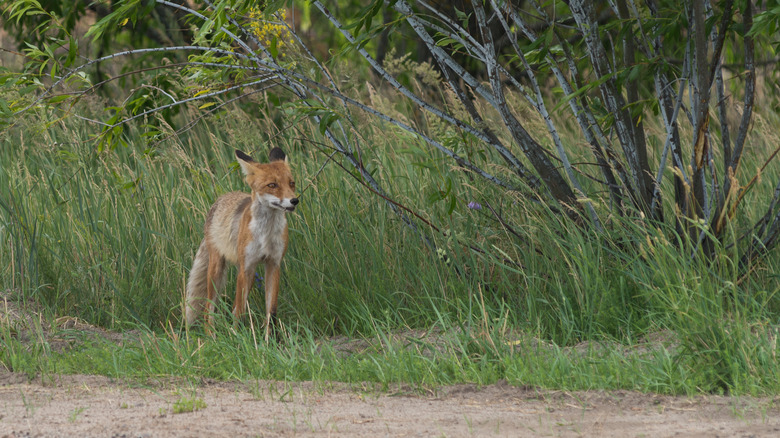The Truth About Animals Living In Chernobyl
Hollywood has made sure that all movie-going humans understand the consequences of nuclear fallout and radiation. It might have surprised you, then, to hear the counterintuitive news that animals living close to the melted-down Chernobyl nuclear plant in Ukraine are doing just fine, thank you very much. Various headlines have trumpeted the amazing story of animal triumph over the man-made disaster, thus proving that the only thing worse for nature than a nuclear disaster is the mere presence of human beings.
The apparently thriving populations of wolves, swallows, endangered horses, and other creatures in and around the Chernobyl exclusion zone (the area that was abandoned after the disaster due to its proximity to the melted-down reactor) seem to provide proof of this, but what you're seeing in those optimistic headlines isn't the complete story. You may think that the absence of multiple limbs, third eyes, and other horrible, visible mutations is proof enough, but not every radiation-induced health problem is something you can see on a camera trap.
For decades, scientists have been studying the wildlife that lives near the site of the 1986 Chernobyl disaster. That's not really surprising since the whole place is like a living nuclear waste experiment that scientists can actually study ethically since no one had to drop a bomb on purpose in order to obtain data about the wide-ranging effects of a huge amount of nuclear radiation. So scientists do know a lot about Chernobyl's animals, and it's not all rosy.
Wolves are doing okay
First, to be fair, it's worth pointing out that some animals do seem to be doing okay even despite the presence of high amounts of radiation. Wolves, for example, appear to be thriving, and there doesn't seem to be anything sinister under the surface of their story. In 2011, the Public Broadcasting Service released a documentary that took a hard look at the wolves of Chernobyl and whether or not they were really as okay as they seemed to be (via Lumen Learning). The documentary followed two German scientists who found high levels of radiation in the bones of moose the wolves had been preying on. Because of this, they expected to also find genetic abnormalities or other health problems in the wolves themselves but found nothing. All the wolves appeared to be healthy.
A 2019 study published by Environment International provided a theory as to why Chernobyl wolves don't seem to have high levels of internal radiation. Because wolves tend to range over long distances, they wrote, the wolves aren't necessarily only eating highly contaminated prey, so the overall amount of radiation they're exposed to through their food is probably less than the high levels of radiation in the moose bones were suggesting. The study also found that external radiation exposure in Chernobyl's wolves was higher than predicted, but it did not comment on the relative health of the animals it was tracking for the study.
Farm animal birth defects
In the weeks and months following the Chernobyl nuclear accident, the kind of stuff people were seeing in area animals was pretty much exactly in line with what most people expected to see. The effects were most noticeable in farm animals, probably because farm animals tend to interact more with people, which allows the effects to be observed more closely.
According to ThoughtCo., 400 deformed farm animals were born in the area around Chernobyl in 1990, just four years after the accident. In some of the worst cases, the animals had extra limbs or malformed heads and faces. Others were just smaller than normal or had strange coloring. Many of the deformities were incompatible with life, and because livestock ranchers depend on healthy broodstock and the annual birth of a new generation, the losses must have been hard to bear both financially and emotionally.
It's probably safe to speculate that these kinds of mutations were also widespread in the local wildlife population, but that's not as well documented because for a long time nobody really dared to go into the exclusion zone to do the kind of population counts that would have been necessary to really get a good idea of how the radiation was affecting area wildlife.
Thyroid damage in cattle
People were evacuated after the disaster; animals weren't. Still, the population of nearby Pripyat remained in the area for 36 hours before they were finally told to evacuate (via History). By then, radiation levels were somewhere between 180 and 300 milliroentgens (via History). That number probably doesn't mean much to you, so let's just say it's dangerously high.
One of the most obvious consequences of human exposure to those high levels of radiation didn't become obvious until years later. According to a study published by Arquivos Brasileiros de Endocrinologia & Metabologia in 2007, a decade after the accident, the rate of thyroid cancer in people living in Belarus, Russia, and Ukraine was 10 times higher than usual. This wasn't just seen in people who had been living in Pripyat, but also in people who were just living in the wider vicinity, though rates did increase the most in people who were closest to Pripyat (via Radiation Risk Assessment of the Thyroid Cancer in Ukrainian Children Exposed Due to Chernobyl).
Area cattle were affected similarly. According to a report by the Belarus Scientific Research Institute for Agricultural Radiology, animals kept in pastures within a half dozen miles or so from the melted down reactor showed signs of radiation-induced thyroid damage within five months of the accident.
Feral pets
When humans were finally evacuated from the exclusion zone, they weren't allowed to take much with them. Officials told them they'd be back in a couple of days, so they left a lot of important things behind, including their pets.
It would be pretty great to imagine that the people living in Pripyat were on board with the modern advice to always spay and neuter their animals, but it was a different time and a different place. Many of the animals that were left behind were intact and survived long enough to reproduce. This is why today there is a large population of feral dogs living in the exclusion zone. Feral cats, evidently, also have established a population in the area.
According to the Russian organization Clean Futures, which also works to help human beings who are still feeling the effects of the Chernobyl disaster, Russian authorities made an early attempt to exterminate the feral dog population in and around Chernobyl. Clean Futures got involved in 2017 and has succeeded in stopping the extermination program. Today, the feral dog population is under control, though it is still large and thriving. Clean Futures traps the animals, sterilizes them, and vaccinates them against diseases like rabies, which could threaten human populations as well as the population of feral animals. They also give the animals food when needed.
Birds have smaller brains
Scientists have done a lot of studies on the impact of the Chernobyl accident on resident birds. Birds make good research subjects because they are just as complex as mammals are but not quite as reclusive (via Science). A 2011 study published by Plos One looked at the brain size of 550 different Chernobyl birds from 48 species. The variety of species gave them information about which species were more vulnerable to the effects of the radiation.
The study found that, on average, the birds had brains that were about 5% smaller than the brains of birds that were not exposed to similar levels of radiation. What's more, they also found that brain size tended to be smaller in younger birds, which implies that it's mostly the larger-brained birds that are living past their first year.
This study was important not just because it helped scientists understand how the radiation might be affecting the local bird population, but because similar effects on brain size have been observed in human beings exposed to radiation. Previously. researchers thought that post-traumatic stress syndrome might be causing the reduction in human brain size, but since birds don't really get PTSD, this study suggests that the radiation itself might be the direct cause.
Bugs and spiders declined
One of the other obvious impacts of the Chernobyl disaster is the reduction in the number of bugs and spiders. Now if you're like most people, you probably think a reduction in bugs and spiders is kind of a good thing. Let's all move to the exclusion zone so we no longer have to evict wolf spiders from our bathrooms.
Sounds nice, but the decline of any insect population is really bad for pretty much everyone. According to National Geographic, insects are at the bottom of the food chain, which means they are a primary food source for small animals like birds, fish, and small mammals. If those smaller animals can't eat insects, then larger animals can't eat smaller animals, and everyone starves except the buzzards. A 2009 study published in Biology Letters looked at bees, butterflies, grasshoppers, dragonflies, and spiders living in forests around Chernobyl. They compared populations in areas with varying levels of radiation and found that the higher the radiation, the fewer insects and spiders there were.
This could have a few implications. First, the people who are still living in the exclusion zone (and there are a few of them) save money on Raid and roach motels. Second, insects are a lot more vulnerable than we thought. In fact, before the research at Chernobyl, scientists thought insects were relatively radiation-proof (via Proceedings of the Royal Society B). Guess they were wrong.
Pollinator reproduction issues
Insects aren't just important for smaller animals, many are also important for humans. Without pollinators, for example, 75% of the world's flowers would not bloom and 35% of the world's food crops would not produce food (via United States Department of Agriculture). So even though they're technically at the bottom of the food chain, they're also the links that hold the food chain together.
Declining pollinators in the exclusion zone may not have much of a ripple effect outside of Ukraine, but they do say something about how vulnerable pollinators are and how vulnerable we all are as a result. A 2012 study published by Oecologia found that areas close to the Chernobyl disaster site that still had high levels of radiation also had significantly fewer pollinators. In 2020, researchers in Scotland did a controlled experiment with bumblebees, which involved dosing them with radiation levels similar to what Chernobyl pollinators were exposed to. They found that the radiation messed with the bees' reproduction and limited colony growth (via Proceedings of the Royal Society B). What's more, this all happened at radiation levels that were a lot lower than the researchers predicted, which suggests that bees may be a lot more vulnerable than we thought they were. Now, hopefully, we're not going to have many more Chernobyl-like events in the world, but bees that are vulnerable to radiation may also be vulnerable to other man-made contaminants, and ultimately that's just bad news for dinner.
Rodent eye problems
Rodents aren't most people's favorite fuzzy animal, but they are the world's largest order of mammals. In fact, around 40% of furry species are rodents (via Animal Diversity), so you may not like them, but you're stuck with them.
Rodents do serve an important function, you know, when they're not infiltrating your garage and defying all attempts at trapping them. They help spread seeds around, they feed hawks and snakes, and they're the world's cleanup crew. They help get rid of scraps and debris and they helpfully spread horrible diseases around and leave their poop all over everything.
If you can get past those last two things, you may be able to garner some sympathy for Chernobyl's rodents, who were just trying to enjoy their good fortune after the human population of Pripyat suddenly abandoned their homes, leaving rodents with a warm place to sleep and lots of free food. But there were consequences. According to Nature, bank voles living in the exclusion zone were found to have high rates of cataracts. Researchers also found that the rate of cataracts in the Chernobyl voles was directly correlated with the amount of radiation the animals had been exposed to. Also, having cataracts didn't just make the voles fumble around in search of cheese, it also seemed to have a direct impact on reproduction. Females with cataracts had smaller litters than typical female bank voles.
Barn swallows' defective sperm
Sometimes an animal may look pretty good from the outside. It's the right size and shape, it doesn't have any extra limbs or eyeballs, it can walk/fly/feed like any other normal member of its species, but internally it's harboring some problematic genetic abnormalities. One of the worst in terms of a species' ultimate biological trajectory is the ability to produce the next generation.
Now, it's perfectly reasonable to think that maybe animals that have other invisible problems like a reduced lifespan or a smaller brain shouldn't pass their genes along at all, but in a place like the exclusion zone, well, someone has to do it. Unfortunately, in the case of Chernobyl's barn swallows, fit candidates are vanishingly uncommon. A 2016 study published in the Bulletin of the Atomic Scientists notes that barn swallows, which are found all over the world and thus represent some of the world's hardiest and most well-studied birds, can be viewed as an "indicator species." In other words, if barn swallows are in trouble, everyone is in trouble. Alarmingly, many of Chernobyl's male barn swallows have sperm that is up to 40% defective, which means their reproductive success is significantly reduced. And just to add some bad news on top of bad news, they also have germline mutations, which are the sorts of mutations that occur inside sperm or egg cells and hence, can be passed on to the next generation.
Albino birds
Chernobyl's birds were affected by the disaster in a lot of different ways, but one of the most visible was the color of their feathers. After the meltdown, there was an increase in partial albinism in the barn swallow population and in other area birds.
In a 2013 study published in Mutation Research/Genetic Toxicology and Environmental Mutagenesis, researchers captured 1,669 Chernobyl birds and recorded 111 cases of partial albinism and 25 tumors. The more partial albinos and tumors there were in a particular area, the less abundant the population was in that area. Another study that looked at partial albinism in Chernobyl barn swallows (via International Journal of Organic Evolution) noted that partial albinism is usually selected against, so these birds aren't likely to pass their defective genes along to others.
Pure albinos don't usually survive long because of vision problems and weaker feathers (via Avian Report), but partial albinos typically have a different set of problems. It's not just that the girls aren't especially into the fancy patchwork plumage, either. According to a 2001 paper published in Evolution, Chernobyl's partial albino barn swallows tended to be smaller than average, and researchers also hypothesized that they may have immunodeficiencies similar to what is seen in humans who have partial albinism. Their color alone probably doesn't have an impact on their fitness — unlike a true albino, partial albinos aren't completely white, so they don't stick out as much to predators.
Animals as far away as Sweden were affected
You could define "Chernobyl's animals" as just the ones living in the exclusion zone, but really, the radiation from the disaster wasn't confined to just the area around the melted-down reactor and Pripyat. According to the Atlantic, after the disaster, radiation kind of swirled around in the air until it got caught up in the wind and carried off to places like Germany, Sweden, and the now-Czech Republic. In fact, according to WorldAtlas, in the days and weeks after the disaster, radiation spread out across Europe over 77,000 square miles, contaminating the meat of farm animals as far away as Finland and Norway. Some of the particles, like radioactive iodine, decay relatively quickly and are now mostly out of the environment, but others may take another thousand years before they're no longer a problem.
Much of Chernobyl's radiation settled in the soil, got absorbed by mushrooms and tubers, and then eventually became food for wild boar. This wouldn't be a huge problem for humans except that: a) wild boar like to knock down fences and destroy human infrastructure and b) people sometimes shoot and eat them. According to the Telegraph, a hog shot in Sweden had 10 times the "safe" level of radiation in its meat, because for some reason there's such a thing as a "safe" level of radiation. Anyway, you probably don't want to have any of that pork for your Sunday dinner.
Species richness and abundance plummeted
One of the ways biologists measure the health of an ecosystem is by looking at species richness and abundance. This basically means that it's not enough for a few species to be thriving in a habitat, there have to be a lot of different species thriving in that habitat, and there has to be a healthy population of each species. The more different animals there are, the more harmony there is within the habitat, and the better each one of those species do overall. Take a few of those cogs out of the wheel, and everything starts to fall apart.
Scientists have been looking at the habitat around the exclusion zone have found that species richness and abundance really isn't that great, despite the fact that a few species appear to be doing well enough to make the front page news. According to a 2016 study published in the Bulletin of the Atomic Scientists, the species richness of birds — that is, the number of bird species living in and around the Chernobyl area — has dropped by about 50% since 1986. Species abundance — the number of individual members of each species — has dropped by about 66%. This is compounded by the fact that there are large numbers of genetic mutations in these animals, coupled with lower survival rates and poor fertility, which means that in spite of appearances, animals, in general, are not doing well in the exclusion zone.
Some species found a safe haven
So yeah, for the animals of Chernobyl, mutations are always a risk, birth rates are low, lifespans are short, and their social lives aren't great given that there just aren't that many other animals around to hang out with. It's not all bad news, though. It is, after all, a (mostly) human-free paradise, and in many ways that's preferable to living somewhere full of human hikers, hunters, gawkers, and bad drivers. Some trade-offs are totally worth it.
Chernobyl has become a haven for a number of endangered animals. Large carnivores like bears and lynx (both considered endangered) have settled into the Chernobyl exclusion zone and appear to be maintaining healthy populations. According to Restoration Ecology, the area is also home to at least 13 pairs of endangered Greater Spotted Eagle. Also, between 1998 and 2004, conservationists made the bizarre decision to release endangered Przewalski's horses into the exclusion zone, which actually appear to be doing okay (via Mammal Research).
It's worth pointing out that its unclear just what this means for endangered species — yes, the Chernobyl exclusion zone is a safe place for them to breed away from human interference, but 30 years after the accident it's still a radiation hotspot and there's always going to be the potential for genetic problems similar to what scientists have seen in more common species. So are they really okay? There's just not enough data available to answer that question.
Animal mutations
Rodents don't tend to stray too far from the garages and sheds they destroy with their poop and their tiny mouse teeth. Deer mice, for example, spend their whole lives roaming around the same four acres (via Wildlife Damage Management). So there's not much chance a rodent might wander away from Chernobyl, bringing all that radiation-soaked genetic baggage along with it.
Other animals, though range widely, and this can be a problem. Wild boar, for example, roam territories that are about 1,000 acres on average (via the University of Nebraska). This means that germline mutations that first appeared in the Chernobyl area could easily be exported outside of the exclusion zone, where they could potentially weaken entire populations of animals and have a lasting negative impact on species fitness overall.
According to a 2006 review published by TRENDS in Ecology and Evolution, mutations could potentially accumulate in exclusion zone populations, spread into other populations, and render all affected animals less able to adapt to environmental change. This is because mutations tend to make animals less able to tolerate stress. The paper's authors also speculated that all those apparently healthy animals that everyone has been crowing about might actually be sink populations, which is a population that has limited reproductive success and therefore doesn't produce enough offspring to keep up the "look how healthy we are" pretenses. So much for all those optimistic headlines.
